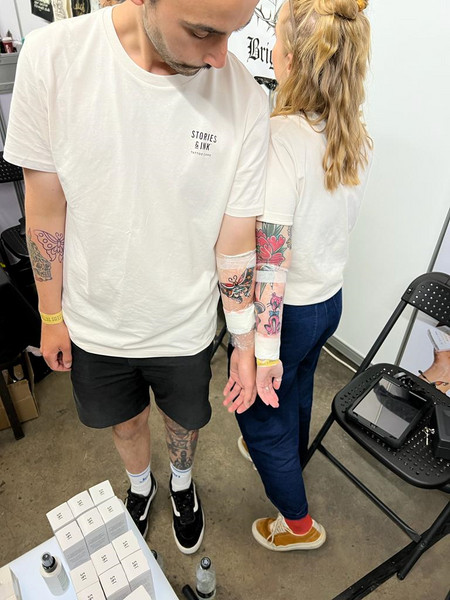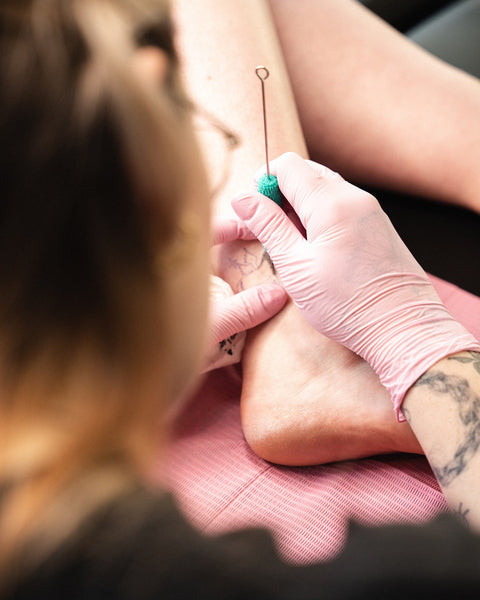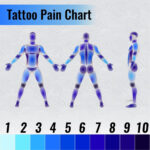Thinking about getting inked but worried about the pain? At tattooat.com, we understand your concerns and offer comprehensive insights into tattoo pain levels across different body areas. Discover the spots that tend to be the most sensitive and learn how to manage the discomfort, ensuring a more comfortable and enjoyable tattoo experience. Explore our curated collection of tattoo designs and aftercare tips to prepare you for your next artistic body modification.
1. What Makes a Tattoo Placement More Painful?
The pain experienced during a tattoo session varies significantly depending on where you choose to get inked. Generally, the worst spots for tattoos are areas where the skin is thin, has many nerve endings, or lies directly over bone with little fat. These areas tend to be more sensitive, leading to a more intense tattooing experience.
Several factors contribute to the level of pain you might feel:
- Nerve Endings: Areas rich in nerve endings, such as the hands, feet, and neck, are typically more sensitive. The increased nerve density means you’ll feel each needle prick more acutely.
- Thin Skin: Thin skin offers less cushioning, making the sensation of the needle more intense. Spots like the ankles, ribs, and sternum are prime examples.
- Bone Proximity: When the skin lies directly over bone, the vibrations and pressure from the tattoo machine can be quite uncomfortable. Knees, elbows, and spines are notorious for this.
- Lack of Fat: Fat acts as a natural cushion. Areas with minimal fat, such as the tops of the feet or the backs of the hands, tend to be more painful.
Understanding these factors can help you make informed decisions about your tattoo placement. If you’re concerned about pain, consider choosing a less sensitive area or discussing pain management options with your tattoo artist.
2. What Are the Most Commonly Reported Painful Tattoo Spots?
While pain is subjective, the most commonly reported painful tattoo spots include the ribs, spine, head, face, neck, armpits, sternum, groin, elbows, knees, ankles, and feet. These areas combine one or more of the factors listed above, leading to a more intense experience.
Let’s break down each of these areas and why they’re considered particularly painful:
- Ribs: Thin skin over bone makes the ribs a very sensitive area.
- Spine: Numerous nerve endings and close proximity to bone amplify the pain.
- Head, Face and Neck: A high concentration of nerve endings and delicate skin contribute to the discomfort.
- Armpits: Sensitive skin and the presence of lymph nodes make this area particularly painful.
- Sternum: Thin skin stretched over bone is a recipe for discomfort.
- Groin: High nerve density and sensitive skin make the groin one of the most painful spots.
- Elbows and Knees: Skin stretched tightly over bone, combined with nerve endings, increases pain.
- Ankles and Feet: Thin skin, minimal fat, and numerous nerve endings make these areas very sensitive.
It’s important to remember that everyone’s pain tolerance differs. What one person finds excruciating, another might find manageable. Consulting with a tattoo artist can provide personalized insights based on the specific design and location you’re considering.
 ankle tattoo
ankle tattoo
3. How Do Pain Levels Differ Between Men and Women for Tattoos?
Pain perception is subjective, but some differences exist in how men and women experience tattoo pain based on physiological and hormonal factors. Generally, areas with more nerve endings or hormonal sensitivity may differ in pain intensity between sexes.
Here’s how pain levels might differ:
- Women:
- Breasts and Sternum: Many women report high pain levels in these areas due to increased sensitivity and nerve endings.
- Ribs: Similar to men, the thin skin and bone proximity make this a challenging spot.
- Men:
- Elbows and Knees: The bony nature of these joints can lead to significant discomfort.
- Feet: Minimal fat and numerous nerve endings contribute to higher pain levels.
Stories & Ink founder Stu has hip and ankle tattoos which he describes as “equal in levels of scratchiness but not unbearable”
These are generalizations, and individual experiences can vary widely. Hormonal fluctuations, particularly in women, can also influence pain perception. Communication with your tattoo artist is crucial to address any specific concerns or sensitivities.
4. Are There Ways to Reduce Tattoo Pain?
Yes, several strategies can help minimize tattoo pain, including using numbing creams, preparing properly for the session, and choosing less sensitive areas. Proper aftercare is also crucial for managing discomfort during the healing process.
Here are some effective ways to reduce tattoo pain:
- Numbing Creams: Topical numbing creams containing lidocaine can significantly reduce pain. Always do a patch test to check for allergic reactions, and inform your tattoo artist before the session.
- Preparation:
- Sleep: Get a good night’s sleep before your appointment to lower your sensitivity to pain.
- Hydration: Stay hydrated to keep your skin supple, which can make the process easier.
- Food: Eat a substantial meal beforehand to maintain stable blood sugar levels and prevent lightheadedness.
- Avoid Alcohol and Caffeine: These can thin your blood and increase sensitivity.
- During the Session:
- Breaks: Don’t hesitate to ask for breaks if the pain becomes overwhelming.
- Distraction: Listen to music, watch a movie, or chat with your artist to take your mind off the pain.
- Breathing Techniques: Practice deep, controlled breathing to stay calm and relaxed.
- Aftercare:
- Proper Cleaning: Keep the tattooed area clean to prevent infections, which can increase pain and prolong healing.
- Moisturizing: Apply a good-quality, fragrance-free moisturizer to keep the skin hydrated and promote healing.
For happy healing, use Stories & Ink’s aftercare duo. Featuring our gentle Aftercare Foam Cleanser and hydrating Aftercare Cream, the Stories & Ink Aftercare Duo is the ultimate in cleansing and healing for fresh tattoos. 100% natural, dermatologically-tested, fragrance free, hypoallergenic, vegan-friendly and suitable for all skin types. Keeps fresh tattoos clean and free from bacteria. Nourishes, hydrates and reduces inflammation. Helps your skin to heal faster.
5. How Does Tattoo Placement Affect Healing Time and Aftercare?
The location of your tattoo significantly impacts healing time and aftercare. Areas with more friction, movement, or exposure to the elements require extra attention to ensure proper healing and prevent complications.
Here’s how different placements can affect healing and aftercare:
- Hands and Feet:
- Challenges: High friction from clothing and shoes, constant movement, and exposure to germs.
- Aftercare: Keep the area clean and dry, wear breathable socks or gloves, and avoid prolonged submersion in water.
- Ribs and Torso:
- Challenges: Friction from clothing, potential for sweating, and discomfort from movement.
- Aftercare: Wear loose-fitting clothing, avoid sleeping on the tattooed side, and keep the area dry and clean.
- Joints (Elbows and Knees):
- Challenges: Constant bending and stretching can disrupt the healing process.
- Aftercare: Keep the area moisturized, avoid restrictive clothing, and limit excessive movement.
- Face and Neck:
- Challenges: Exposure to sunlight and environmental pollutants, difficulty in keeping the area clean.
- Aftercare: Use sunscreen, keep the area clean with mild soap, and avoid harsh skincare products.
Barbara agrees, saying “the worst to heal were my armpits, and honestly, that was worse than getting my ribs and neck tattooed.”
Proper aftercare is crucial, regardless of the tattoo’s location. Follow your tattoo artist’s instructions carefully, and don’t hesitate to reach out if you have any concerns.
6. What Are Some Less Painful Tattoo Placement Options?
If you’re concerned about pain, consider choosing areas with thicker skin, fewer nerve endings, and more fat. These spots tend to be less sensitive, making the tattooing experience more comfortable.
Here are some less painful tattoo placement options:
- Outer Thigh: Thick skin and plenty of muscle make this a relatively painless area.
- Outer Arm: Similar to the thigh, the outer arm has fewer nerve endings and more cushioning.
- Calves: While there’s some bone proximity, the muscle mass in the calves helps reduce pain.
- Upper Back: A good balance of skin thickness and fewer nerve endings makes this a popular choice for first-timers.
- Forearm: This area has fewer nerve endings and is not directly over bone.
Choosing a less painful area can make your first tattoo experience more enjoyable. As you become more comfortable with the process, you can consider venturing into more sensitive areas for future tattoos.
7. How Can Tattoo Size and Design Impact the Pain Level?
Larger and more intricate tattoos generally cause more pain due to the longer time spent under the needle. The complexity of the design and the techniques used can also affect the level of discomfort.
Here’s how tattoo size and design can impact pain:
- Size: Larger tattoos require more time and repeated passes with the needle, leading to increased pain and skin irritation.
- Complexity: Intricate designs with fine details and shading involve more needlework, prolonging the discomfort.
- Techniques: Certain techniques, such as heavy shading or color packing, can be more painful than simple line work.
- Location: A large, complex tattoo in a sensitive area will be significantly more painful than a small, simple design in a less sensitive location.
If you’re concerned about pain, consider starting with a smaller, simpler tattoo in a less sensitive area. You can always add to it later as your tolerance increases.
 fine line tattoos
fine line tattoos
8. What Is the Difference Between Machine Tattoos and Hand-Poked Tattoos in Terms of Pain?
Hand-poked tattoos are often perceived as less painful than machine tattoos due to the gentler, more controlled application. However, the experience can vary depending on individual pain tolerance and the skill of the artist.
Here’s a comparison of machine tattoos and hand-poked tattoos in terms of pain:
| Feature | Machine Tattoos | Hand-Poked Tattoos |
|---|---|---|
| Application | Uses an electric machine to rapidly insert ink into the skin | Uses a single needle to manually poke ink into the skin |
| Pain Level | Generally more intense due to the speed and vibration of the machine | Often described as less intense due to the slower, more controlled method |
| Precision | Can achieve very precise and intricate designs | Best suited for simpler designs with less detail |
| Time | Typically faster than hand-poked tattoos | Takes longer to complete, especially for larger designs |
| Skin Trauma | Can cause more trauma to the skin due to the machine’s rapid movement | Generally less traumatic to the skin due to the gentler application |
Many people say they’re more gentle. Or choose a design that’s simple, perhaps using fine lines
Hand-poked tattoos can be a good option for those with low pain tolerance or those seeking a more traditional tattooing experience. However, they may not be suitable for complex or highly detailed designs.
9. How Does Skin Hydration Affect Tattoo Pain and Healing?
Proper skin hydration is crucial for minimizing tattoo pain and promoting faster healing. Hydrated skin is more supple and resilient, making it easier for the needle to penetrate and reducing irritation.
Here’s how skin hydration affects tattoo pain and healing:
- Reduced Pain: Well-hydrated skin is more flexible and less prone to tearing, which can reduce the pain experienced during the tattooing process.
- Faster Healing: Hydrated skin heals more quickly and efficiently. Moisture helps the skin repair itself and reduces the risk of infection.
- Improved Ink Absorption: Hydrated skin absorbs ink better, resulting in a more vibrant and long-lasting tattoo.
- Less Irritation: Hydrated skin is less likely to become dry, itchy, or inflamed, reducing discomfort during the healing process.
To maintain proper skin hydration:
- Drink Plenty of Water: Aim for at least eight glasses of water per day to keep your skin hydrated from the inside out.
- Moisturize Regularly: Apply a high-quality, fragrance-free moisturizer to your skin several times a day, especially after showering or washing your hands.
- Avoid Harsh Soaps: Use gentle, hydrating soaps that won’t strip your skin of its natural oils.
- Use a Humidifier: If you live in a dry climate, use a humidifier to add moisture to the air and prevent your skin from drying out.
10. What Role Does the Tattoo Artist Play in Managing Pain?
A skilled tattoo artist can significantly influence your pain level through their technique, communication, and willingness to adjust the process to your comfort. Choosing an experienced and compassionate artist is crucial for a positive tattoo experience.
Here’s how a tattoo artist can help manage pain:
- Technique: Experienced artists use techniques that minimize trauma to the skin, reducing pain and promoting faster healing.
- Communication: A good artist will communicate with you throughout the process, explaining what to expect and checking in on your comfort level.
- Breaks: They should be willing to take breaks as needed to allow you to rest and recover.
- Numbing Products: They can advise you on the use of numbing creams and other pain-relieving products.
- Distraction: Some artists use music, movies, or conversation to distract you from the pain.
- Aftercare Advice: They will provide detailed aftercare instructions to help you manage discomfort and prevent complications during the healing process.
When choosing a tattoo artist, look for someone who is not only skilled but also patient, understanding, and willing to work with you to create a positive and comfortable experience. Check out tattooat.com to find talented artists and reputable studios across the USA, especially in vibrant cities like Portland, known for its thriving tattoo culture.
Exploring the world of tattoos involves understanding the potential pain and how to manage it effectively. Whether you’re drawn to intricate designs or minimalist art, knowing the most and least painful spots can guide your choices. At tattooat.com, we offer a wealth of resources to inspire your next tattoo, connect you with talented artists, and provide expert aftercare advice.
Ready to start your tattoo journey? Visit tattooat.com today to discover stunning designs, find experienced artists, and learn everything you need to know about tattoo care. Explore our extensive gallery, read detailed guides, and join a community of tattoo enthusiasts. Your perfect tattoo experience starts here. Address: 1825 SW Broadway, Portland, OR 97201, United States. Phone: +1 (503) 725-3000. Website: tattooat.com.
FAQ: The Worst Spot to Get a Tattoo
1. Is getting a tattoo on my ribs really that bad?
Yes, the ribs are often cited as one of the most painful places to get a tattoo. The skin is thin and lies directly over the bone, with fewer fat layers to cushion the needle. This combination makes the sensation more intense.
2. What makes the inner thigh so painful for a tattoo?
The inner thigh is sensitive due to the thin skin and numerous nerve endings in the area. This makes the tattooing process more intense compared to areas with thicker skin and fewer nerve endings.
3. How can I prepare for a tattoo on a particularly painful spot?
To prepare for a tattoo in a sensitive area, ensure you are well-rested, hydrated, and have eaten a good meal. You might also consider using a numbing cream, but always consult with your tattoo artist first.
4. Are there any tattoo placements that are generally considered painless?
While no tattoo is entirely painless, areas with more fat, fewer nerve endings, and thicker skin, such as the outer thigh or upper arm, are generally less painful.
5. Can the size of the tattoo affect how much it hurts?
Yes, larger tattoos typically hurt more because they require longer sessions and more repeated passes with the needle over the same area, increasing the overall discomfort.
6. Why are tattoos on the feet and ankles so painful?
Tattoos on the feet and ankles are painful because these areas have thin skin, are close to the bone, and contain many nerve endings. Additionally, the skin is often more sensitive due to constant use and friction.
7. Does the healing process differ for tattoos in painful areas?
Yes, tattoos in painful areas often require more careful aftercare. These areas can be more prone to swelling and irritation, so it’s essential to follow your artist’s aftercare instructions closely to promote proper healing.
8. Is it true that women experience more pain during tattoos than men?
Pain tolerance varies greatly from person to person, regardless of gender. Hormonal fluctuations and individual differences in pain perception can influence how much pain someone experiences during a tattoo.
9. Are hand-poked tattoos less painful than machine tattoos?
Hand-poked tattoos are often perceived as less painful because they involve a slower, more controlled application of ink. However, the level of pain can still vary depending on the individual and the artist’s technique.
10. Can my tattoo artist help minimize the pain during the tattoo process?
Yes, a skilled tattoo artist can minimize pain by using proper techniques, taking breaks as needed, and offering advice on pain management. Communicating openly with your artist about your pain level is essential for a more comfortable experience.
